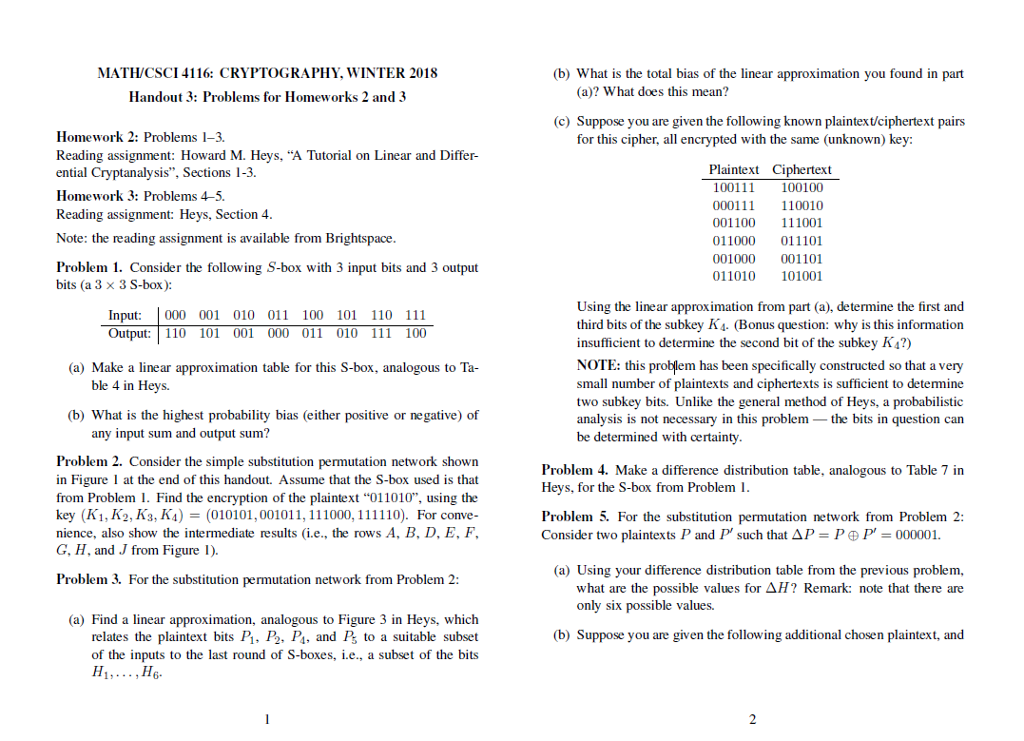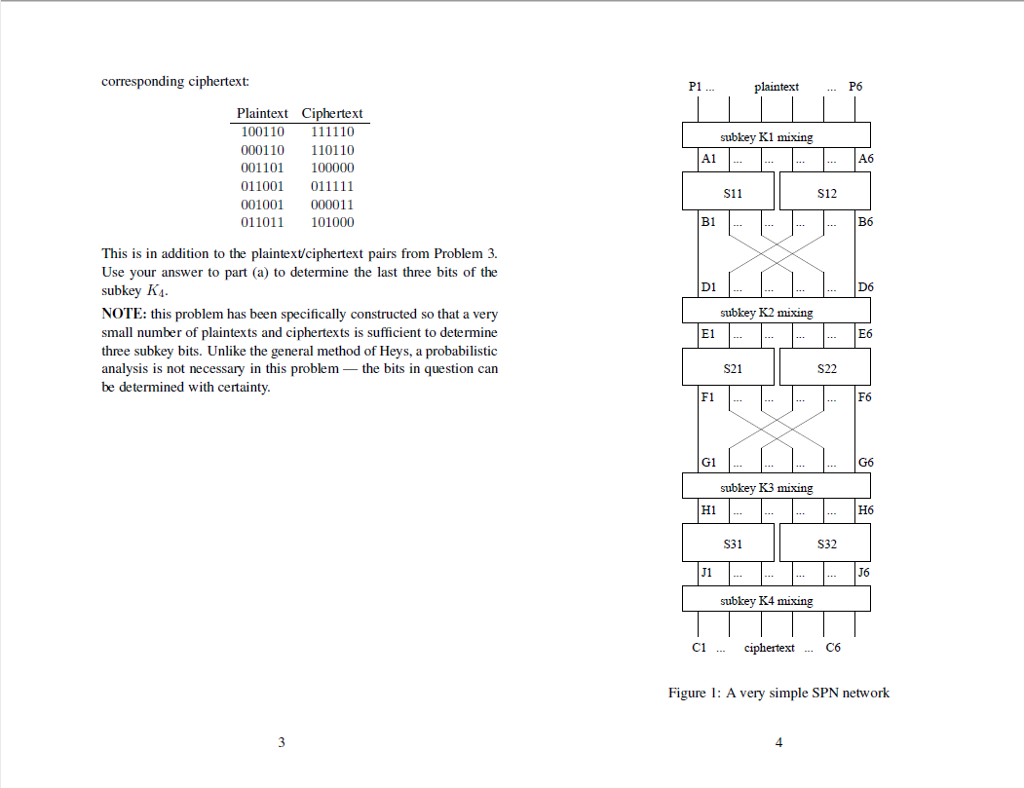PLZ ANSWER problem 4


MATH/CSCI 4116: CRYPTOGRAPHY,WINTER 2018 (b) What is the total bias of the linear approximation you found in part Handout 3: Problems for Homeworks 2 and 3 (a)? What does this mean? (c) Suppose you are given the following known plaintext/ciphertext pairs Homework 2: Problems 1-3. Reading assignment: Howard M. Heys, "A Tutorial on Linear and Differ ential Cryptanalysis", Sections 1-3. Homework 3: Problems 4-5. Re for this cipher, all encrypted with the same (unknown) key: Plaintext Ciphertext 00111 100100 00011 110010 001100 111001 011000 011101 001000 001101 011010 101001 ading assignment: Heys, Section 4 Note: the reading assignment is available from Brightspace Problem 1. Consider the following S-box with 3 input bits and 3 output bits (a 3 x 3 S-box): Input: 000 001 010 011 100 101 110 111 Output: 110 101 001 000 011 010 1 100 Using the linear approximation from part (a), determine the first and third bits of the subkey K4. (Bonus question: why is this information insufficient to determine the second bit of the subkey K4?) NOTE: this problem has been specifically constructed so that a very small number of plaintexts and ciphertexts is sufficient to determine two subkey bits. Unlike the general method of Heys, a probabilistic analysis is not necessary in this problemthe bits in question can (a) Make a linear approximation table for this S-box, analogous to Ta- ble 4 in Heys. (b) What is the highest probability bias (either positive or negative) of any input sum and output sum? be determined with certainty Problem 2. Consider the simple substitution permutation network shown in Figure I at the end of this handout. Assume that the S-box used is that from Problem 1. Find the encryption of the plaintext "011010", using the Problem 4. Make a difference distribution table, analogous to Table 7 in Heys, for the S-box from Problem I Problem 5. For the substitution permutation network from Problem 2 Consider two plaintexts P and P' such that P-P P' 000001. nience, also show the intermediate results (i.e., the rows A, B, D, E. F G, H, and J from Figure 1). Problem 3. For the substitution permutation network from Problem 2: (a) Using your difference distribution table from the previous problem, what are the possible values for H? Remark: note that there are only six possible values. (a) Find a linear approximation, analogous to Figure 3 in Heys, which relates the plaintext bits P1, P2, P, and P to a suitable subset of the inputs to the last round of S-boxes, i.e, a subset of the bits (b) Suppose you are given the following additional chosen plaintext, and MATH/CSCI 4116: CRYPTOGRAPHY,WINTER 2018 (b) What is the total bias of the linear approximation you found in part Handout 3: Problems for Homeworks 2 and 3 (a)? What does this mean? (c) Suppose you are given the following known plaintext/ciphertext pairs Homework 2: Problems 1-3. Reading assignment: Howard M. Heys, "A Tutorial on Linear and Differ ential Cryptanalysis", Sections 1-3. Homework 3: Problems 4-5. Re for this cipher, all encrypted with the same (unknown) key: Plaintext Ciphertext 00111 100100 00011 110010 001100 111001 011000 011101 001000 001101 011010 101001 ading assignment: Heys, Section 4 Note: the reading assignment is available from Brightspace Problem 1. Consider the following S-box with 3 input bits and 3 output bits (a 3 x 3 S-box): Input: 000 001 010 011 100 101 110 111 Output: 110 101 001 000 011 010 1 100 Using the linear approximation from part (a), determine the first and third bits of the subkey K4. (Bonus question: why is this information insufficient to determine the second bit of the subkey K4?) NOTE: this problem has been specifically constructed so that a very small number of plaintexts and ciphertexts is sufficient to determine two subkey bits. Unlike the general method of Heys, a probabilistic analysis is not necessary in this problemthe bits in question can (a) Make a linear approximation table for this S-box, analogous to Ta- ble 4 in Heys. (b) What is the highest probability bias (either positive or negative) of any input sum and output sum? be determined with certainty Problem 2. Consider the simple substitution permutation network shown in Figure I at the end of this handout. Assume that the S-box used is that from Problem 1. Find the encryption of the plaintext "011010", using the Problem 4. Make a difference distribution table, analogous to Table 7 in Heys, for the S-box from Problem I Problem 5. For the substitution permutation network from Problem 2 Consider two plaintexts P and P' such that P-P P' 000001. nience, also show the intermediate results (i.e., the rows A, B, D, E. F G, H, and J from Figure 1). Problem 3. For the substitution permutation network from Problem 2: (a) Using your difference distribution table from the previous problem, what are the possible values for H? Remark: note that there are only six possible values. (a) Find a linear approximation, analogous to Figure 3 in Heys, which relates the plaintext bits P1, P2, P, and P to a suitable subset of the inputs to the last round of S-boxes, i.e, a subset of the bits (b) Suppose you are given the following additional chosen plaintext, and








